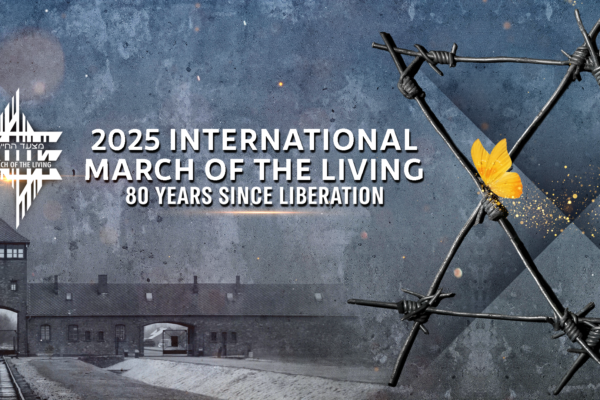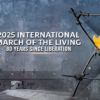
March of the Living in the streets of Budapest lead by Katharina von Schnurbein, EU Coordinator for combatting Antisemitism, Israeli and American Ambassadors, Gabor Gordon, Chairman of the Hungarian March of the Living and Michel Gourary, Director of the European March of the Living.
5,000 Marchers Join Budapest March of the Living on Hungarian National Holocaust Remembrance Day
Hundreds will join the March of the Living in Poland together with some 10,000 participants from around the world
The 19th March of the Living in the streets of Budapest took place on the Hungarian National Holocaust Remembrance Day, with the participation of dozens of Holocaust survivors and Righteous Among the Nations, joined by thousands of marchers, mainly non-Jewish.
Gabor Gordon, Founder and the Chairman of the March of the Living in Hungary, opened the march, which was dedicated this year to victims of forced labour during the Holocaust. 100,000 slave labourers, mostly Jews, were forced to serve in labour camps – almost 60,000 perished as a result of hard work, inhumane and cruel treatment and other brutal circumstances. Among them Gabor recalled the tragedy of Attila Petschauer, a legendary fencer and two-time Olympic champion, who died in force labour service, 80 years ago, on January 20, 1943. A Hungarian lieutenant colonel, who had competed in equestrian races at the 1928 Olympics, forced the Jewish fencing champion to be stripped naked and doused in icy water at a temperature of 40 degrees below zero.
Katharina von Schnurbein, the European Commission Coordinator for Combating Antisemitism and Fostering Jewish Life, was the guest of honor of the March of the Living in Budapest.
She said: “We are gathered today for the March of Living to commemorate the Hungarian Jewish men, women and children, that were murdered in the Shoah. The Holocaust was a European tragedy, but it happened locally. And not every victim was a Jew, but every Jew was a victim”.

Katharina von Schnurbein (credit)
Von Schnurbein explained that in October 2021 the European Commission presented its first-ever EU strategy on combating antisemitism and fostering Jewish life and emphasized: “We want to ensure the broad public understands the roots and danger of antisemitism. We want to provide effective ways to learn the lessons from the Holocaust and to remember. We are building a European network of places where the Holocaust happened. We want to make sure deportation sites, places where Jews were rounded up, but also places where Jews were hidden are marked and become part of public knowledge. To show how local it happened and to never forget. We hope that places such as the Budapest ghetto will become part of that European network. 20 years ago Holocaust survivor Elie Wiesel asked at a conference hosted by the European Commission: “Why do always the Jews have to speak up against antisemitism – where are all the others?” I am pleased that here today the Jewish community in Budapest is joined by “all the others”.
The Israeli ambassador to Hungary, Yaakov Hadas-Handelsman, stressed: “This march is one of the largest marches in Europe against antisemitism and racism and is certainly the biggest, most peaceful and civil demonstration in Hungary as well”. The ambassador thanked those “who stood up against antisemitism or any other kind of discrimination, and all those who did not remain silent!”
Michel Gourary, Director of the European March of the Livin,g conveyed his deep appreciation to the March of the Living of Hungary for their continuous efforts to keep the memory of the Holocaust alive. “We commend your fantastic and innovative educational work when for example more than 160,000 visitors, mainly high school students, visited your wagon exhibit in the last 14 years, guided by young Hungarian High School students who were trained by the dedicated team of March of the Living of Hungary.”
“We will continue to support your efforts and our other partners’ efforts to organize national and local Marches of the Living and Marches of Remembrance in the centers of other European cities where the Jews used to live until they were taken to their horrible deaths during the Holocaust. And for that reason, we are marching here today in Budapest to remember the hundreds of thousands of Hungarian Jews who were brutally killed during the Holocaust. We are also remembering how nearly 80,000 Jews, including old people, young children and pregnant women, were forced to start on November 8, 1944, their horrible death march of some 220 km from Budapest to the border of Austria. This death march was initiated by Adolf Eichmann, one of the major organizers of the Holocaust who was impatient to deport Hungarian Jews and could not wait for trains to arrive in Budapest.”

Gabor Kovacs (credit: Doron Ritter)
A delegation from Hungary is on its way to attend the annual March of the Living in Poland, a three kilometre from between the Auschwitz and Birkenau death camps. They will join some 10,000 participants from around the world. Traveling with the delegation is Hungarian Holocaust survivor Gabor Kovacs. Kovacs was born in Budapest on March 31, 1932. He lost his father in the Holocaust who was deported in October 1944 and perished in Mauthausen in January 1945. He spent the most difficult days with his mother in the Budapest Ghetto. The Red Army liberated them on January 18, 1945.
“The Holocaust did not start with the enforced wearing of the yellow star. It began much earlier, with the creation of hatred during the two decades following World War I. It started with discriminatory laws against Jews. We must not allow discrimination against people. Education should begin in kindergarten. If children receive a different kind of education at home than they receive through the educational system, it can create a serious conflict. Antisemitism still exists, but its forms and tools have adapted to our era. Creating hatred is unacceptable!” says Kovacs.







